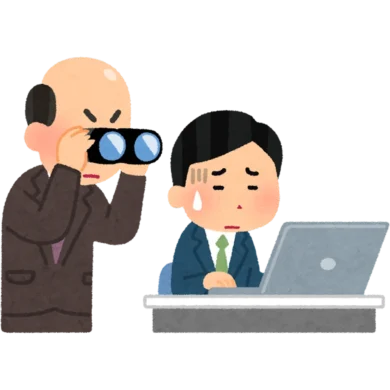In your journey as a freelancer, you’ve likely relished the freedom and flexibility that comes with steering your own ship. Yet, this freedom occasionally encounters rough seas in the form of micromanaging clients. These clients feel compelled to monitor every detail of your work process, often blurring the line between constructive involvement and overbearing supervision.
Facing a micromanaging client is a rite of passage in the freelance world. You may find yourself under the watchful eye of someone who demands unreasonably frequent updates and revisions or provides painstakingly detailed instructions for tasks you’re more than well-equipped to handle. While their motives might be rooted in a pursuit of perfection or previous setbacks, the impact on you can lead to unnecessary stress, diminished creativity, and a strained working relationship. But fear not. There are techniques and approaches to managing these clients without sacrificing your professionalism or peace of mind.
Here, we’ll walk through the common tell-tale signs that you’re dealing with a micromanager, understand why it happens, and most crucially, how to handle these clients without it turning into a battle or damaging your hard-earned reputation. It’s time to take back control without burning bridges.
Understanding Micromanagement in Freelancing
At first glance, micromanagement might seem like a harmless preference for detail, but it’s far more complex and potentially detrimental than that. It’s a blend of excessive oversight and a pronounced lack of faith in a freelancer’s capacity to execute tasks. Micromanaging clients often take it upon themselves to scrutinize and sometimes even redo each phase of a project. This behavior isn’t born out of a simple desire for control. Usually, it originates from deeper-seated issues such as an intense fear of failure or a compulsive need to maintain control over every aspect of a project.
For freelancers, the impact of being micromanaged can be profound and disheartening. It undermines the core reasons many choose the freelance path in the first place: the allure of creative freedom and the autonomy to make decisions based on one’s expertise. The essence of freelancing is grounded in trust—a mutual belief that the freelancer has been engaged for their unique skills and insight to bring a project to fruition. Yet, for some clients, relinquishing control poses a significant challenge, particularly when their emotional or financial investment in the project is substantial.
However, it’s crucial to distinguish between micromanagement and a client’s intrinsic attention to detail. Not all clients who prefer to stay closely involved in the project process are micromanagers. Some clients naturally lean towards a detailed approach and favor frequent communication. Yet, they do so while respecting boundaries and acknowledging the freelancer’s expertise and contribution to the project. These clients understand that while they may guide the project’s direction, they better leave the execution in the capable hands of the freelancer they chose to trust.
The differentiation between constructive involvement and micromanagement lies in the dynamic of control and respect. In a healthy client-freelancer relationship, there’s a balanced exchange of ideas, and feedback is given constructively, recognizing the freelancer’s professional autonomy. In contrast, a micromanaging client often struggles to find this balance, tipping the scales towards an environment where the freelancer feels more like a puppet than a partner in the project’s success.
Recognizing the fine line between diligent oversight and micromanagement is vital. It enables you to navigate your relationships with clients more effectively, ensuring that collaboration doesn’t turn into suffocation. By understanding the root causes and manifestations of micromanagement, you can better equip yourself to address and mitigate its impact, fostering a healthier, more productive working relationship that benefits both parties.
Signs You’re Dealing With a Micromanaging Client
Micromanaging clients, though often well-intentioned, can unwittingly impede the progress and morale of a project with their overbearing approach.
Recognizing the hallmark signs of such behavior can empower you to address the situation proactively. Here’s a closer look at these indicators:
Excessive Detailing Required
If clients insist on knowing the minutiae of how and when every task is performed, it’s a red flag. This excessive oversight can lead to inefficiencies, as you spend more time reporting than working.
Anxiety over Minor Decisions
A micromanaging client might show undue stress over small decisions, a sign they struggle to trust your judgment, leading to unnecessary delays and discussions.
Real-time Monitoring
The need for real-time work monitoring or constant updates undermines trust and autonomy, creating a pressured and uncomfortable working environment.
Overemphasis on Procedure Over Outcome
If a client focuses more on how you should do the tasks rather than the results, it could be a sign of micromanagement. They may prioritize adherence to specific processes over creativity and efficiency, which can stifle your ability to deliver your best work.
Difficulty Delegating Tasks
Micromanagers often have trouble delegating tasks without retaining control over how those tasks are executed. They might delegate a task to you but then micromanage each step, making it difficult for you to use your expertise and judgment effectively.
Lack of Decision-making Autonomy
If your client rarely allows you to make decisions within your area of expertise and insists on approving even minor details, this is a classic sign of micromanagement. It can slow the project’s progress and diminish your role to that of an implementer rather than an expert.
Frequent Interruptions
Frequent, unscheduled check-ins or communications interrupting your workflow can indicate a micromanaging client. These interruptions break your focus and suggest a lack of trust in your ability to manage your time and work effectively.
Requests for Unnecessary Reporting
A demand for detailed reports or frequent updates that seem excessive for the project’s scope or stage is a red flag. While transparency is crucial, overly burdensome reporting requirements can signify micromanagement
Strategies to Cope with Micromanaging Clients
Communication Strategies
Establish Clear Communication Protocols: From the beginning, it’s essential to set expectations about how and when communication will occur. This includes:
- Choosing preferred communication channels (email, phone, messaging apps) to streamline discussions.
- Setting a schedule for updates to prevent constant check-ins, such as weekly status reports or bi-weekly calls, thus reducing the impulse for frequent interruptions.
Define Boundaries and Response Times: Make it clear what your working hours are and how quickly you can realistically respond to queries. This helps manage expectations regarding your availability and discourages out-of-hours contact.
Manage Overbearing Interactions: When conversations start to overstep, gently guide them back on track. For example, if a client is delving too deeply into how you’re executing tasks (beyond what’s necessary for clarity), kindly remind them of your expertise and the agreed-upon goals.
Empowerment Techniques
Demonstrate Your Expertise: Consistently delivering top-notch work on schedule is the strongest argument against micromanagement. It reassures clients of your capability and reliability.
Be Proactive: Anticipate potential issues or questions and address them before they arise. Proactively presenting solutions or improvements can build trust and showcase your commitment to the project’s success.
Position Yourself as a Thought Leader: Encourage your clients to see you as a partner who brings valuable insights, not just someone who executes tasks. This can shift their perspective and reduce their need to micromanage.
Seek Feedback and Adjust as Necessary
Constructive feedback is invaluable. Use it as an opportunity to understand your client’s concerns and adjust your approach if possible. Showing willingness to adapt can ease tensions and build a stronger working relationship.
Educate Your Client
Some clients may not be familiar with the norms of freelancing. Educate them on how trust, respect for expertise, and autonomy can lead to better project outcomes. Sharing examples of successful projects or processes can help illustrate your points.
Engage the Client in the Process: Find ways to involve the client that play to their strengths or interests. For example, if they have a keen eye for design, ask for input on design elements. Involving them constructively can shift their focus from micromanaging to collaborating.
Communicate the Impact of Micromanagement: Respectfully communicate how excessive oversight affects your ability to deliver your best work. Some clients may not realize the impact of their actions and may be open to changing their approach once they understand its effects.
Establish a Detailed Project Plan
Create a Comprehensive Project Outline: Before starting the work, draft a detailed project plan that includes milestones, deadlines, and deliverables. Present this plan to the client for approval. This roadmap can serve as a reference point for both parties, reducing the client’s need to micromanage by providing clarity on what will be delivered and when.
Include Checkpoints: Build in regular checkpoints or milestones where you can review progress together. This structure can help clients feel more involved and reassured without the need for constant oversight.
Use Positive Reinforcement
Highlight Achievements: When you hit a milestone or receive positive feedback, share it with your client. This reinforces the value of your work and can build confidence in your abilities, potentially reducing their perceived need to micromanage.
Thank Your Client for Their Trust: When your client allows you more autonomy, acknowledge and thank them for their trust. Positive reinforcement can encourage them to continue this behavior.
Leverage Technology
Project Management Tools: Utilize project management software to keep tasks, documents, and feedback in one place. These tools often allow for status updates and comments, giving micromanaging clients a way to stay informed without directly interrupting your workflow.
Shared Documents: Use shared documents (like Google Docs) for collaborative work where real-time input is necessary. This can provide a transparent platform for progress and revisions, satisfying a client’s need for oversight while maintaining efficiency.
Set Incremental Trust-building Goals
Start with Smaller Projects: If possible, begin your relationship with smaller projects or portions of the project to build trust incrementally. Success in these smaller endeavors can pave the way for greater autonomy in larger projects.
Request Trial Periods for Autonomy: Propose a trial period where you work with more autonomy, with the promise of a review at the end. This can help ease the client into a more hands-off approach by demonstrating that the quality of work or project success won’t suffer.
By integrating these techniques and strategies, you can more effectively manage relationships with micromanaging clients, leading to healthier working dynamics and more successful project outcomes.
Address Issues With Tact
Prepare Your Points: Before initiating a conversation about micromanagement, prepare your key points. Highlight specific instances where micromanagement has hindered the project’s progress or your productivity. It’s helpful to come with examples and possible solutions rather than just presenting problems.
Choose the Right Moment: Timing can significantly impact how your message is received. Choose a moment when no immediate stress or deadline is looming. A calm, neutral time allows for a more productive discussion.
Focus on the Project’s Benefit: Frame your conversation around the project’s success and how a change in approach could enhance outcomes. For example, you might explain how reducing daily check-ins could free up more time for actual work, leading to faster project completion and higher-quality results.
Suggest Specific Workflow Changes: Offer concrete suggestions for adjusting the workflow. This might include shifting from daily updates to a weekly comprehensive report or using a project management tool to track progress transparently.
Emphasize Your Commitment: Reassure your client of your commitment to the project’s success and your willingness to keep them informed. The goal is to build trust, showing that less direct oversight does not mean less dedication to quality and deadlines.
When to Say No (or Goodbye)
Deciding to end a professional relationship with a micromanaging client requires careful consideration and diplomatic action. Here’s an expanded approach to determining when it might be time to say no or goodbye and how to do so while maintaining professionalism and integrity.
Assessing Your Well-being and Project Success
Evaluate the Impact on Your Mental Health: Continuous micromanagement can lead to stress, anxiety, and burnout. If you find the relationship draining your energy and affecting your mental well-being, it’s crucial to consider your health above all. Remember, no project is worth compromising your peace of mind.
Consider the Quality of Your Work: Micromanagement can stifle creativity and hinder your ability to produce your best work. If you notice a decline in the quality of your deliverables due to constant interference, it might be time to reassess the relationship.
Reflect on the Value of the Relationship: Consider the project’s value, both financially and in terms of career growth. If the negatives outweigh the positives, and there’s little room for negotiation or improvement in the working dynamic, it may be prudent to part ways.
Seek Advice: Sometimes, it can be helpful to talk to a mentor, peer in your industry, family member, or friend. They can offer a fresh perspective and suggest strategies you haven’t considered.
Exiting Professionally
Communicate Your Decision Clearly: Once you’ve decided to end the relationship, schedule a meeting to discuss it in person (or via a video call if in-person isn’t possible). Be direct but polite in your approach, focusing on the facts and keeping emotions in check.
Provide a Reasonable Notice Period: Offer an appropriate notice period to avoid leaving your client in a difficult position. Depending on the agreement and nature of the work, this time can be used to wrap up your current work, document processes, or transition the project to someone else.
Offer to Help with the Transition: Propose ways to ensure a smooth handover, such as preparing detailed documentation, recommending another freelancer or agency, or even training the new person taking over. This gesture can go a long way in maintaining a positive relationship post-exit.
Keep the Door Open: Unless the situation is untenable, it’s wise to leave on good terms. The freelance world is small, and paths may cross again under different circumstances. Express your willingness to remain in contact and potentially collaborate on future projects that are more aligned with your working styles.
Document Your Exit: Ensure all communications regarding your decision to exit are documented via email or in writing. This includes your notice, any agreements made for the transition, and final work submissions. It helps prevent misunderstandings and ensures both parties are clear on the terms of the separation.
Ending a client relationship is never easy, but sometimes it’s necessary for your well-being and professional growth. By handling the situation with care, professionalism, and foresight, you can ensure a graceful exit that preserves your reputation and leaves the door open for future opportunities.
Conclusion
Dealing with micromanagers as a freelancer can be a challenging aspect of the job. However, by employing the right strategies, you can transform these often draining experiences into valuable lessons in negotiation, communication, and client management.
Remember, not all clients who exhibit close involvement are micromanagers. With clear communication, the demonstration of your expertise, and the willingness to educate and engage with your clients, you can transform a potentially toxic situation into one that enhances your professional skills and the success of your projects.
Call to Action
Have you faced micromanaging clients in your work? How did you handle it? Share your experiences and strategies in the comments below. Collaborating with other freelancers can provide insights and support in dealing with micromanagement, so join the conversation and empower yourself in your freelancing career.







